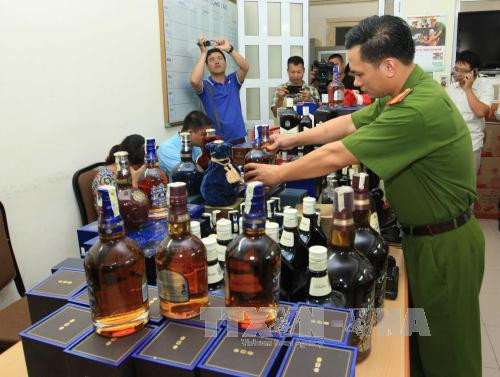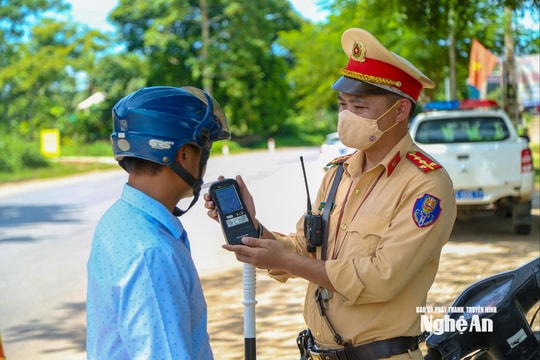Examine the bottom of the bottle to distinguish real and fake wine
(Baonghean.vn) - The closer to Tet, the more "lively" the market for fake and smuggled alcohol becomes. Fake alcohol affects the health of consumers. So how to distinguish fake alcohol?
According to medical experts, alcohol that does not guarantee quality, fake alcohol can cause acute poisoning, many cases leading to death. In fake alcohol, poor quality alcohol often has high concentrations of methanol or aldehyde, these are substances that have a very strong impact on nerve cells and can quickly cause low blood pressure, dizziness, vomiting, blurred vision ... leading to death, if not treated promptly, it can also lead to blindness, many cases leave sequelae that cannot restore vision ...
Hanoi police busted a gang producing and selling fake foreign alcohol. Photo: Doan Tan/VNA. |
The following tips will help you gain knowledge and experience in distinguishing between fake and real wine:
Check import stamps, anti-counterfeit stamps:Some famous brands such as Chivas, Martell, Royal Solute Salute... often have anti-counterfeit stamps in the form of fragile stamps stuck on the neck of the bottle, which cannot be peeled off and are very easy for consumers to check and identify.
Consumers can identify genuine stamps by wetting the stamp with water or by using a highlighter pen. A fluorescent light will shine on the stamp and the brand name will appear as real wine. Fake wine cannot do this.
Bottle outer shell:Usually, fake wine bottles on the market use the shell and cap of real wine bottles that are illegally purchased. Because the bottle cap has been removed by the bartenders at the restaurant with a specialized tool, without tearing the label, as well as breaking the seal and then smuggling it out, there will be cracks on the edge, even when the cap is closed by machine, these cracks will not disappear.
Wine level in the bottle:Normally, famous brands in the world are industrially produced and bottled automatically, so in principle, the color of the wine as well as the level of wine inside the bottles are very even. Counterfeit wine is handmade, so the color and level of wine inside the bottle are often uneven. When observing a row of wines of the same brand in the store, if you see a bottle with a different level of wine than the other bottles, you can suspect that it may be a fake bottle, and continue to check the following factors.
Check the wine label:The big difference between real wine labels and fake wine bottle labels is that fake labels cannot imitate the embossing, metallic colors, etc. of the original brand.
Check the lid/button:Counterfeiters often reuse real lids, or outright fake lids. Reused real lids may still have small scratches from the process of opening the lid, and the color of the fake lid looks dull, the grooves of the fake lid do not look as delicate and regular as the real lid…
Check the bottom of the bottle:There are some types of wine that are counterfeited by drilling a very small hole, like a hair, at the bottom of the bottle to take out the real wine and pump in the fake wine. Therefore, when buying, you should observe carefully at the bottom of the bottle, if there are strange traces, you should not buy.
If you receive a gift and want to know if the wine is real or fake, put it in the freezer and take it out after 12 hours. If it freezes, it may be fake.
Alcohol test:Pour a little wine into the palm of your hand, rub your hands together and then bring it to your nose to smell. If you smell a strong alcohol smell, the wine has a high alcohol content and could be fake wine made from alcohol.
Fake wine has no aroma when drunk, tastes a bit bitter, and feels harsh in the mouth. You may have a headache after drinking.
In addition to the above tips, when buying wine, consumers should choose reputable stores or ask relatives to buy it for them from their home country.
| When purchasing, the buyer must ask the seller for an invoice, agreement or carefully check the warranty conditions before purchasing. In particular, when buying counterfeit goods, the buyer should keep the goods in their original condition so that they can contact the seller to request an exchange or refund, compensation, and at the same time notify the Market Management agencies and the police for handling. |
NN(Synthetic)
| RELATED NEWS |
|---|




.jpg)
.jpg)



